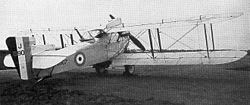Fairey Fawn
| Fairey Fawn | |
|---|---|
 1. Prototype with a short body and a tank |
|
| Type: | light day bomber |
| Design country: | |
| Manufacturer: | |
| First flight: |
1923 |
| Commissioning: |
January 1924 |
| Production time: |
1923 to 1926 |
| Number of pieces: |
68 |
The Fairey Fawn was a two-seat light biplane that was used as a day bomber in British service . The first flight of the aircraft was in 1923. In 1924 the No. 11, No. 12 and No. 100 Squadron of the Royal Air Force (RAF) from the DH9A to the Fairey Fawn. It was also used in two new bomber units, the No. 503 and the 603 Squadron .
The Fawn was originally intended as a scout. After the conversion of the experimental amphibious aircraft Fairey Pintail and construction of the prototypes MK I and MK II with a longer fuselage to improve the longitudinal stability, it turned out to be more suitable as a bomber. In 1923 the first order for 48 aircraft started, followed by a series of Fawn MK III aircraft with 20 aircraft.
Technical specifications
| Parameter | Data |
|---|---|
| crew | 2 |
| length | 9.78 m |
| span | 15.21 m |
| height | 3.63 m |
| Wing area | 51.1 m² |
| Wing extension | |
| Empty mass | 1582 kg |
| Takeoff mass | 2646 kg |
| Top speed | 183 km / h at sea level |
| Rate of climb | 5000 ft (1520 m) in 6:30 min |
| Service ceiling | 4220 m |
| Range | 1045 km |
| Engines | a Napier Lion II piston engine with 350 kW (476 hp) |
| Armament | two 7.7 mm machine guns , up to 209 kg bombs as external load |
